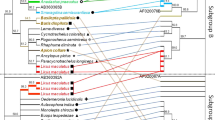Abstract
Wolbachia are cytoplasmically inherited alpha-proteobacteria well known for inducing a variety of reproductive abnormalities in the diverse arthropod hosts they infect. Despite their obligate intracellular lifestyle which usually protects bacteria from phage infection, Wolbachia harbor a widespread temperate phage called WO. Evidences of horizontal phage transfers indicate that this phage could promote genetic exchanges between strains leading to evolutionary changes in the genomes of Wolbachia, and could be involved in the phenotypes these bacteria induced. In this study, we report the survey of Wolbachia and WO phage infections in 20 populations of the Uzifly Exorista sorbillans, a tachinid endoparasite of silkworm Bombyx mori, collected from different geographic regions of India. Previous studies demonstrated that Wolbachia is associated with positive reproductive fitness effects in this species. Polymerase chain reaction using the ftsZ gene encoding for a Wolbachia cell division protein and the orf7 capsid protein gene of the phage showed that all flies checked were infected by Wolbachia and its phage WO. Phylogenetic analyses based on the Wolbachia surface protein gene revealed 100% of double infections by the arthropod supergroups A and B. These results can serve as a valuable basis for understanding the evolution of Wolbachia bacteria and may provide information about the dynamics of Wolbachia–host associations. This knowledge could be exploited for the use of Wolbachia for effective control strategies of the Uzifly, a serious menace of the silkworm B. mori.


Similar content being viewed by others
References
Baldo L, Bordenstein S, Wernegreen JJ, Werren JH (2006) Widespread recombination throughout Wolbachia genomes. Mol Biol Evol 23:437–449
Bordenstein SR, Reznikoff WS (2005) Mobile DNA in obligate intracellular bacteria. Nat Rev Microbiol 3:688–699
Bordenstein SR, Wernegreen JJ (2004) Bacteriophage flux in endosymbionts (Wolbachia): infection frequency, lateral transfer, and recombination rates. Mol Biol Evol 21:1981–1991
Brownlie JC, Johnson KN (2009) Symbiont-mediated protection in insect hosts. Trends Microbiol 17:348–354
Gavotte L, Vavre F, Henri H, Ravallec M, Stouthamer R, Boulétreau M (2004) Diversity, distribution and specificity of WO phage infection in Wolbachia of four insect species. Insect Mol Biol 12:147–153
Gavotte L, Henri H, Stouthamer R, Charif D, Charlat S, Boulétreau M, Vavre F (2007) A survey of the bacteriophage WO in the endosymbiotic bacteria Wolbachia. Mol Biol Evol 24:427–435
Guindon S, Gascuel O (2003) A simple, fast, and accurate algorithm to estimate large phylogenies by maximum likelihood. Syst Biol 52:696–704
Holden PR, Brookfield JFY, Jones P (1993) Cloning and characterization of an ftsZ homologue from a bacterial symbiont of Drosophila melanogaster. Mol Gen Genet 240:213–220
Kent BN, Bordenstein SR (2010) Phage WO of Wolbachia: lambda of the endosymbiont world. Trends Microbiol 18:173–181
Lo N, Casiraghi M, Salati E, Bazzocchi C, Bandi C (2002) How many Wolbachia supergroups exist? Mol Biol Evol 19:341–346
Masui S, Kamoda S, Sasaki T, Ishikawa H (2000) Distribution and evolution of bacteriophage WO in Wolbachia, the endosymbiont causing sexual alterations in arthropods. J Mol Evol 51:491–497
Masui S, Kuroiwa H, Sasaki T, Inui M, Kuroiwa T, Ishikawa H (2001) Bacteriophage WO and virus like particles in Wolbachia, an endosymbiont of arthropods. Biochem Biophys Res Commun 283:1099–1104
Miao EA, Miller SI (1999) Bacteriophages in the evolution of pathogen host interactions. Proc Natl Acad Sci USA 96:9452–9454
Moran NA, McCutcheon JP, Nakabachi A (2008) Genomics and evolution of heritable bacterial symbionts. Ann Rev Genet 42:165–190
Oliver KM, Degnan PH, Hunter MS, Moran NA (2009) Bacteriophages encode factors required for protection in a symbiotic mutualism. Science 325:992–994
Perrot-Minnot MJ, Guo LR, Werren JH (1996) Single and double infections with Wolbachia in the parasitic wasp Nasonia vitripennis: effects on compatibility. Genetics 143:961–972
Puttaraju HP, Prakash BM (2005) Effects of Wolbachia in the uzifly, Exorista sorbillans, a parasitoid of silkworm, Bombyx mori. J Insect Sci 5(30):1–7
Ronquist F, Huelsenbeck JP (2003) MR BAYES 3: Bayesian phylogenetic inference under mixed models. Bioinformatics 19:1572–1574
Rousset F, Solignac M (1995) Evolution of single and double Wolbachia symbioses during speciation in the Drosophila simulans complex. Proc Nat Acad Sci USA 92:6389–6393
Sambrook J, Fritsch EF, Miniatis T (1989) Molecular cloning: a laboratory manual, 2nd edn. Cold Spring Harbor Laboratory Press, Cold Spring Harbor
Stouthamer R, Breeuwer JA, Hurst GD (1999) Wolbachia pipientis: microbial manipulator of arthropods reproduction. Annu Rev Microbiol 53:71–102
Taylor MJ, Bandi C, Hoerauf A (2005) Wolbachia bacterial endosymbiont of filarial nematodes. Adv Parasitol 60:245–284
Werren JH, Zhang W, Guo LR (1995) Evolution and phylogeny of Wolbachia: reproductive parasites of arthropods. Proc R Soc Lond B 261:55–63
Zhou W, Rousset F, O’Neill S (1998) Phylogenetic and PCR-based classification of Wolbachia strains using wsp gene sequences. Proc R Soc Lond B 265:509–515
Acknowledgment
Funding for this study was provided by grants from DST, Government of India to HPP (SR/SO/AS-77/2008).
Author information
Authors and Affiliations
Corresponding author
Rights and permissions
About this article
Cite this article
Guruprasad, N.M., Mouton, L., Sumithra et al. Survey of Wolbachia and Its Phage WO in the Uzifly Exorista sorbillans (Diptera: Tachinidae). Curr Microbiol 63, 267–272 (2011). https://doi.org/10.1007/s00284-011-9973-6
Received:
Accepted:
Published:
Issue Date:
DOI: https://doi.org/10.1007/s00284-011-9973-6




